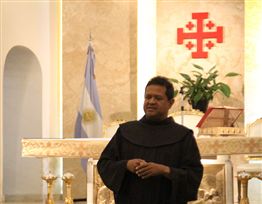The first evidence of the Franciscans in Argentina dates back to 1692. Since then, the Franciscans have never stopped being an important reference for the local population, as is also the case with Fr. Rafael Sube Jimenéz. In charge of the monastery of the Custody of the Holy Land in Buenos Aires, as Commissioner of the Holy Land, as well as the legal representative of the Instituto Tierra Santa, Fr. Rafael spends much of his time for others. What is peculiar about the Buenos Aires monastery is that it is part of the Custody of the Holy Land, while being located in a territory outside the Middle East mission.
Some time has passed since celebration of the official visit to Argentina by the Custos, Fr. Francesco Patton, in November, and daily life has resumed with its usual rhythms and difficulties. “In Argentina, the problem is that people live a very superficial life,” said the Commissioner of Buenos Aires. “And then you live in a violent environment, where there are verbal confrontations, protests against the Church and the contaminations to the social environment. This is a problem we have to solve by educating children in an environment of harmony in our school.” He was speaking about the Instituto Tierra Santa, the school of the Custody which now has 800 students, between 3 and 18 years of age, as well as 170 staff members.
The life of Fr. Rafael begins early in the morning. “The day starts with prayer, breakfast and then I go to the Commissariat,” explained the friar. “I also go by the school and then sometimes I go back to the monastery, because people ask me for confession or sometimes they just need someone to listen to them.” His work for the Church is comprehensive, and he is also active in his dialogue with the bishops and with people who want to make donations to the holy places. “A challenging part of the job is also staying at the school, helping the kids, speaking with the teachers,” continued Fr. Rafael. “People also seek me out to go visit the sick, because we are close to a hospital and they need someone to bless the dead.” The heart of his mission is singular: “For me the most important thing is to teach people about the the Holy Land,” said the friar. Among his responsibilities is in fact, his role as Commissioner, who acts as a bridge between the holy places and his nation. Why travel to the Holy Land? According to Fr. Rafael, “first and foremost, in order to know our origins, and secondly because the Holy Land changes one’s heart, one’s life and strengthens our faith. That is what is referred to as the ‘grace of the holy places.’ We cannot explain it. You have to experience it.”
In the Franciscan fraternity of Buenos Aires there are five friars, after the last chapter of the Custody decided to increase their number, making it easier to carry out daily tasks. They come from four different countries: Mexico, Brazil, Argentina and Chile.
The Instituto Tierra Santa is an important part of the educational mission supported by the Franciscans. Although Fr. Rafael is its legal representative, the work of the school of the Custody of the Holy Land is carried out mainly by lay people, with the support of the friars. “When I arrived in Buenos Aires, my first impression was that there was a peaceful environment at the school,” explained Fr. Rafael. “Seven, eight months later, I found out that there were major problems: administrative, economic. Over the years, I have worked a lot. They were difficult years, but also the intervention of former Custos, Fr. Pierbattista Pizzaballa, was helpful: he came here many times, during his term. The commitment of the Franciscans is recognized in the creation of an atmosphere of brotherhood, harmony, help for the needy, which means even covering the cost of tuition and expenses for some of the students.
The monastery of the Custody in Buenos Aires was also a welcome center for Franciscan vocations from all over South America. During his has visit, the Custos of the Holy Land, said that he hoped that vocations be encouraged again at this time. How does one go about this? Fr. Rafael already knows where to start: “We should try to be authentic, because we cannot show the kids a life that is not real. The youngsters are looking for a quiet life, a vocation, a mission; they are searching for a way of life. And when they see that you are kind, respectful toward them, you know, joking with them, and at the right time, they will come and ask you why you are this way. St. Francis used to say that our preaching should be our life.”
Being at the service of the Church in Argentina for years also means having crossed paths with Jorge Mario Bergoglio, when he was still in Buenos Aires. “It was nice to know a cardinal like him,” recalled Fr. Rafael joyfully. The first contact I had with him was through mobile phone: I called his office to see if there was the possibility of setting up appointment. I left my cell phone number with the secretary and twenty minutes later I got a call. ‘You are the Mexican who has arrived? I’m Bergoglio,’ he said to me.” It was 2007 and it was the first time that Fr. Rafael met the future Pope Francis. The then-cardinal, after asking him to choose the day and time for their meeting, had come down to open the doors and to accompany him in his studio. “He was very fraternal and that is not very common with the cardinals. Since he has become pope, I have not seen him yet, but he is the same person, only dressed in white. He truly is an authentic person.”
Beatrice Guarrera, Custodiae Terrae Sanctae


